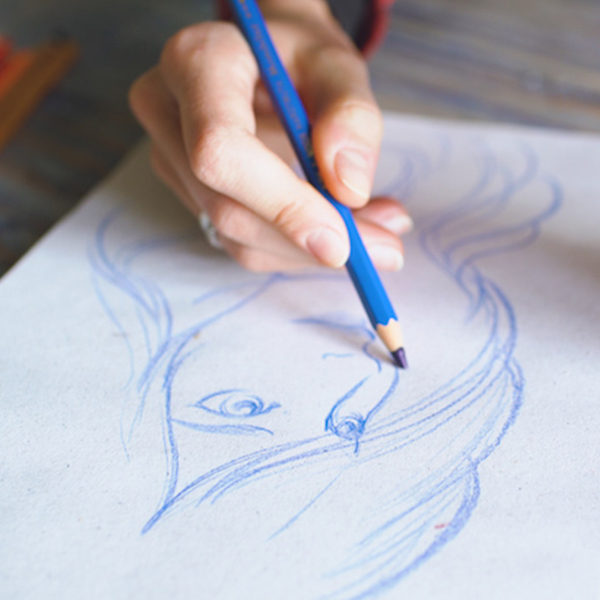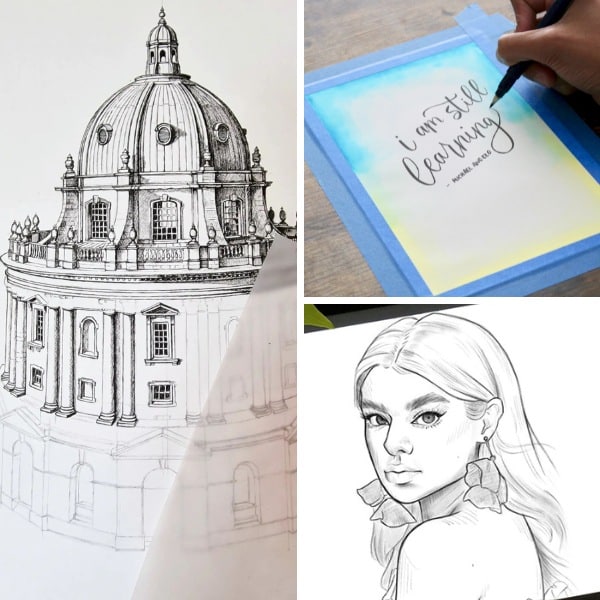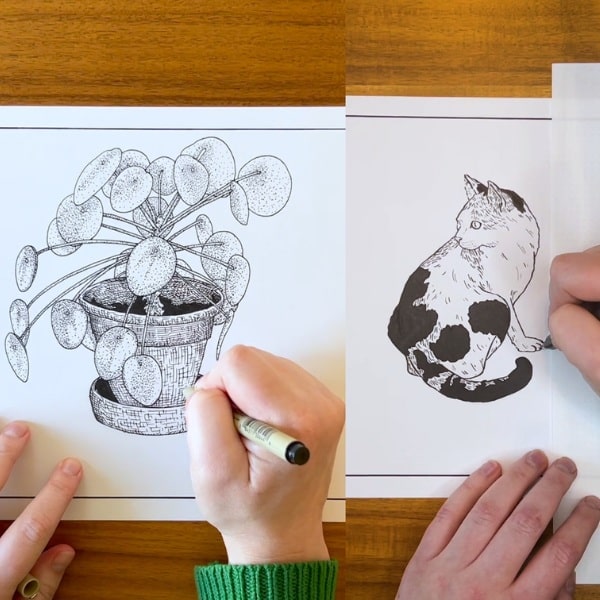
Stock Photos from Africa Studio/Shutterstock
This post may contain affiliate links. If you make a purchase, My Modern Met may earn an affiliate commission. Please read our disclosure for more info.
You’ve got a lot of choices for tools when it comes to drawing. Pencils are the most popular, simply because they are so ubiquitous. But the more you get into drawing, the more you’ll want to experiment with media to figure out what you like using the best. Charcoal, for instance, is a popular tool for artists—especially those that like to sketch and do it fast.
Why Should You Try Charcoal Drawing?
Charcoal is a smooth yet brittle material that has similar properties to chalk pastel. The dark substance comes in different forms—some are hard while others are soft—but overall it offers a quick sketching experience. Lighter, less dense charcoal is particularly adept at flying over the page and is great for casual sketches. But, don't underestimate the incredible depth it can achieve. If you are working on a drawing that has deep shadows, charcoal will have the rich black tones you want to convey that sort of intensity.

Photo: Stock Photos from Burhan Bunardi/Shutterstock
Different Types of Charcoal
There are three popular types of charcoal. All are used for drawing, but each has special qualities that make them appropriate for different points in your art.
Willow Charcoal and Vine Charcoal
Willow and vine charcoal come in long, wispy strips. It is the most delicate charcoal, and you don’t have to press very hard on your page to use it. This makes it best for quick sketches, where you’re trying to capture something as it’s happening; your hand will glide across the page.
Because vine charcoal is so delicate, (you can easily crush it between two fingers) you can’t get as dark as you would with other types of charcoal. If you’re going to use it for a more polished drawing, you’ll want to reserve it for lighter values.
Try this: Winsor & Newton Artist Vine Charcoal Sticks
Compressed Charcoal
Compressed charcoal has a very similar structure to chalk pastels. It is powdered charcoal held together with a binder of gum or wax. This type of charcoal is harder than willow and vine, and it will maintain its shape as you draw. Because of this, it’s great for details in a charcoal drawing with well-defined lines and textures.
Compressed charcoal comes in sticks or its more popular pencil form. The pencil is very handy because you can sharpen to get a nice point.
Try this: General Pencil Compressed Charcoal Sticks or Mont Marte Woodless Charcoal Pencils
Powdered Charcoal
Vine and compressed charcoal are both in stick form and can be held in your hand. Powdered charcoal, in contrast, is exactly how it sounds—it’s dusty. To use this, you’ll want to have a paintbrush or cloth handy and be prepared to get messy. This type of charcoal is great for filling in larger areas.
Try this: Coates Willow Powdered Charcoal
Other Charcoal Drawing Supplies
Before you start drawing, you will need some more charcoal drawing materials.
Charcoal Paper
Choose your paper wisely. You'll want to select something with texture to it, meaning that when you run your hand over the paper, you will feel tiny bumps. Drawing onto a toothy surface will help to extract some of the charcoal onto the paper. Look for a paper that's above 100 pounds so that it can absorb all of the layers of charcoal. However, don't feel limited to white paper. Black charcoal works well with different tones as well such as gray, brown, and tan paper.
Try this: Legion Paper Stonehenge Multi-Color Paper Pad
White Eraser
Charcoal is messy! If you’re working on a finished drawing, you’re going to want to erase any smudges or stray marks made. Grab a white vinyl eraser to get rid of them.
Try this: Staedtler Mars Plastic Vinyl Eraser
Kneaded Eraser
In a charcoal drawing, a kneaded eraser is another way to give your work depth. This special type of eraser looks like putty and is soft, too. It can be pulled and stretched into all different shapes, making it easy to dab it on the paper to pick up the charcoal powder.
A popular technique with a kneaded eraser in charcoal art is called reductive drawing. In this style of drawing, you are using the eraser to take away the powder and build form. This is great for highlights.
To clean a kneaded eraser, simply pull it apart until it returns to its natural gray color.
Try this: Prismacolor Kneaded Eraser
Chamois
If you’d prefer to keep your hands as clean as possible, try using a chamois cloth to blend your charcoal. You can wash this with water once it gets too full of charcoal.
Try this: Natural Artist Chamois
Tortillon
A tortillon, also known as a blending stump, is another way to smudge your charcoal without having to dirty your fingers.
Try this: Lowell-Cornell Blending Stumps
White Charcoal (or Pastel)
White charcoal, sometimes referred to as white pastels, offers another way to define highlights in your drawing. Its composition is similar to that of compressed charcoal and it comes in stick or pencil form. In most cases, you’ll want to use it sparingly as an accent.
Try this: General Pencil White Charcoal Pencil
Fixative
One of the downsides of working with charcoal is that it won’t permanently adhere to your drawing surface. Some particles are bound to fall off when moving your paper. Use fixative to solve this problem. There are two types: one is called workable fixative, which allows you to go back in and draw on your paper. The other is a final fixative, which is permanent and should only be used if you’re not planning on changing your art.
Make sure that these are used in well-ventilated areas.
Try this: Krylon Workable Fixatif and Krylon Matte Finish Spray
Charcoal Drawing Techniques

Photo: Stock Photos from joannawnuk/Shutterstock
If you’re sketching with a pen or a pencil, you’ve got a ton of drawing techniques at your expense. Those materials aren’t as prone to smudging, so it’s easier to create hatching, cross-hatching, stippling, and more. Charcoal, because it has a chalky finish, doesn’t lend itself as well to those more precise techniques. You’ll want to focus on blending and layering charcoal instead.
Blending allows the substance to be pressed into the paper and gives it a better chance of sticking to your page. In doing this, however, the tone will become lighter. So, as you blend, it’s important to layer and build up your tones. First, use the back-and-forth approach to cover the area of your paper with charcoal. Once you’ve coated it, use your finger, a chamois, or a tortillon to press it into the page. Repeat this step until you’ve reached your desired intensity.
When creating your charcoal drawing, don’t be afraid to mix types of charcoal. This will help build tone as well and allow you to define detail in your drawing. Start with the vine charcoal to depict large shapes and set the overall tone of your drawing. Once the lighter and mid-tones are created, use the compressed charcoal in areas of deep shadow or edges that need defining. As you draw, be sure that you don’t go too dark too fast. Charcoal, especially compressed, can be unforgiving and hard to completely erase. By starting lighter you’ll be able to control how much charcoal is on the page and avoid going overboard on tones.
Once you’re done using the compressed charcoal, consider your highlights. White charcoal is ideal for this, as is using a kneaded eraser for reductive drawing.
Charcoal Video Tutorial
Books About Drawing With Charcoal
Charcoal Drawing Ideas
Before you pick up a piece of vine charcoal, get inspiration from artists working with it.
View this post on Instagram
View this post on Instagram
View this post on Instagram
Show off your charcoal drawing when you join our Art, Design, Photography, and Drawing Club on Facebook!
This article has been edited and updated.
Related Articles:
100+ Drawing Ideas That Will Get You Sketching Right Now
7 Fun Drawing Games That Challenge You to Flex Your Creativity Muscles
New to Drawing? Make Sure You Know These Basic Techniques Before You Start






















































































